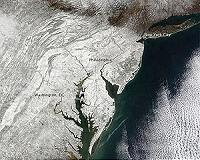| . |  |
. |
Richland WA (SPX) Feb 12, 2010 An international team of climate scientists will take a new approach to modeling the Earth's climate future, according to a paper in 11 February Nature. The next set of models will include, for the first time, tightly linked analyses of greenhouse gas emissions, projections of the Earth's climate, impacts of climate change, and human decision-making. This approach will influence the next international scientific assessment undertaken by the Intergovernmental Panel on Climate Change (IPCC). It will provide the framework for thousands of individual scientific studies on climate impacts and adaptation, climate modeling, and changes in the way societies generate and use energy. "This is an open-ended approach that enables us to compare the environmental and socio-economic effects of different potential responses to climate change," said lead author Richard Moss, a scientist with the Department of Energy's Pacific Northwest National Laboratory who performs climate change impacts research at the Joint Global Change Research Institute in College Park, Md. Moss has been a long-time contributor to the IPCC, previously directed the office of the US Global Change Research Program, and served as vice president for climate programs at the World Wildlife Fund. "This comparative evaluation is extremely important to determine the technical, policy and economic requirements for reaching whatever society decides is a safe level of climate change. We hope to provide decision-makers with better tools to help people deal with a shifting climate," he said.
Vulnerability and adaptation: going beyond the gases In the new process, researchers will use scenarios to evaluate human contributions to climate change, the response of the Earth system, the impacts of a wide range of future climates, and the effects of different response options and policies to reduce net emissions and adapt to new climate conditions. To do so, the scientists wanted a more comprehensive endpoint than greenhouse gas accumulation and a more comprehensive view of the world as the climate changes. "We wanted to explore how environmental and social vulnerability would evolve. In addition to considering how much, when and where climate changes, we also need to consider how different human futures will influence the impacts of climate change," said Moss. The scientists defined four possible climate futures by how much of the sun's energy the atmosphere retains. Multiple factors affect this, including greenhouse gas accumulation, the presence of atmospheric particles, land use and other features. The scientists called each of these futures a "representative concentration pathway," or RCP. Many independent groups of scientists will use the RCPs in climate models to project changes in a range of climate conditions including temperature, precipitation and extreme events. In addition to focusing on the usual century-long time scales typical for climate studies, one set of experiments will focus intensively on the next few decades to provide better information on regional changes and extreme events, thus aiding decision-makers in planning adaptations to new, imminent conditions.
Many paths to the future This type of modeling will focus on population and economic growth, the evolution of technologies, and other factors such as governmental policies and societal institutions. Analyses will include not only human activities that contribute to climate change but also the extent of vulnerability of different populations and what resources will be available to adapt to new conditions. Following this initial modeling, other teams of researchers will then use the results of these climate and socio-economic studies in a wide range of research on the potential effects of climate change on natural resources, human health, coastal infrastructure, ecosystems and other sectors. This work will employ models of water resources, crop yields, disease vectors, ecosystems and other resources to assess how different levels of climate change will affect the things of greatest value to humankind.
International and interdisciplinary collaboration Teams of scientists developed the process over a three-year period and through a series of interdisciplinary and international meetings. More than 150 researchers met in one meeting in the Netherlands in 2007 under the auspices of the IPCC to consider many different aspects of the problem - energy and the economy, the earth sciences, and the responses of people and communities - and to develop recommendations for the approach.
Share This Article With Planet Earth
Related Links DOE/Pacific Northwest National Laboratory Climate Science News - Modeling, Mitigation Adaptation
 US climate skeptics seize on blizzard
US climate skeptics seize on blizzardWashington (AFP) Feb 11, 2010 US opponents of climate change action are seizing on a record snowfall in Washington in hopes of killing legislation to curb carbon emissions, which already faced uncertain political prospects. Environmentalists have launched a swift counter-attack, pointing out that Olympics host Vancouver is facing a dearth of snow and saying the extreme weather may in fact offer proof, not a rebuttal, of ... read more |
|
| The content herein, unless otherwise known to be public domain, are Copyright 1995-2010 - SpaceDaily. AFP and UPI Wire Stories are copyright Agence France-Presse and United Press International. ESA Portal Reports are copyright European Space Agency. All NASA sourced material is public domain. Additional copyrights may apply in whole or part to other bona fide parties. Advertising does not imply endorsement,agreement or approval of any opinions, statements or information provided by SpaceDaily on any Web page published or hosted by SpaceDaily. Privacy Statement |